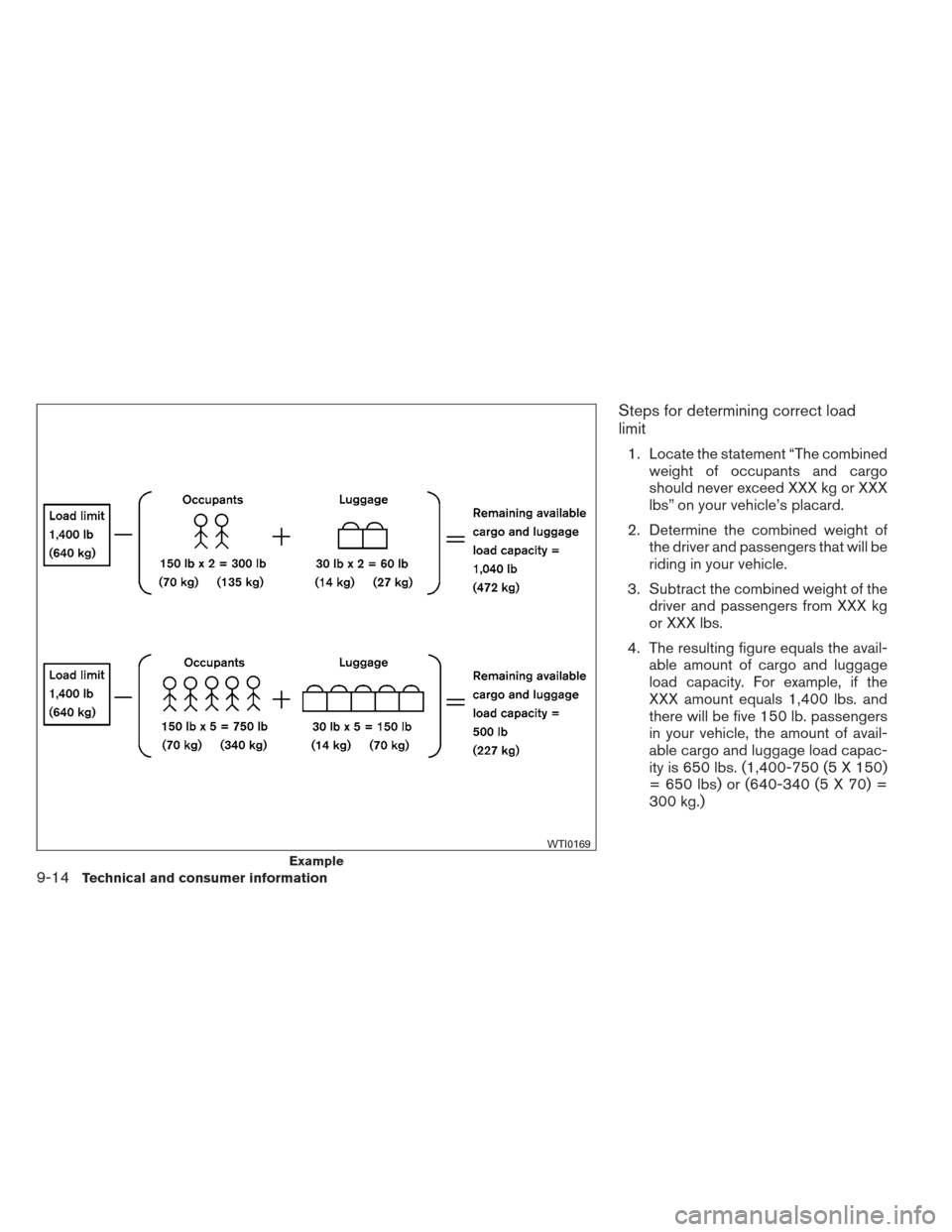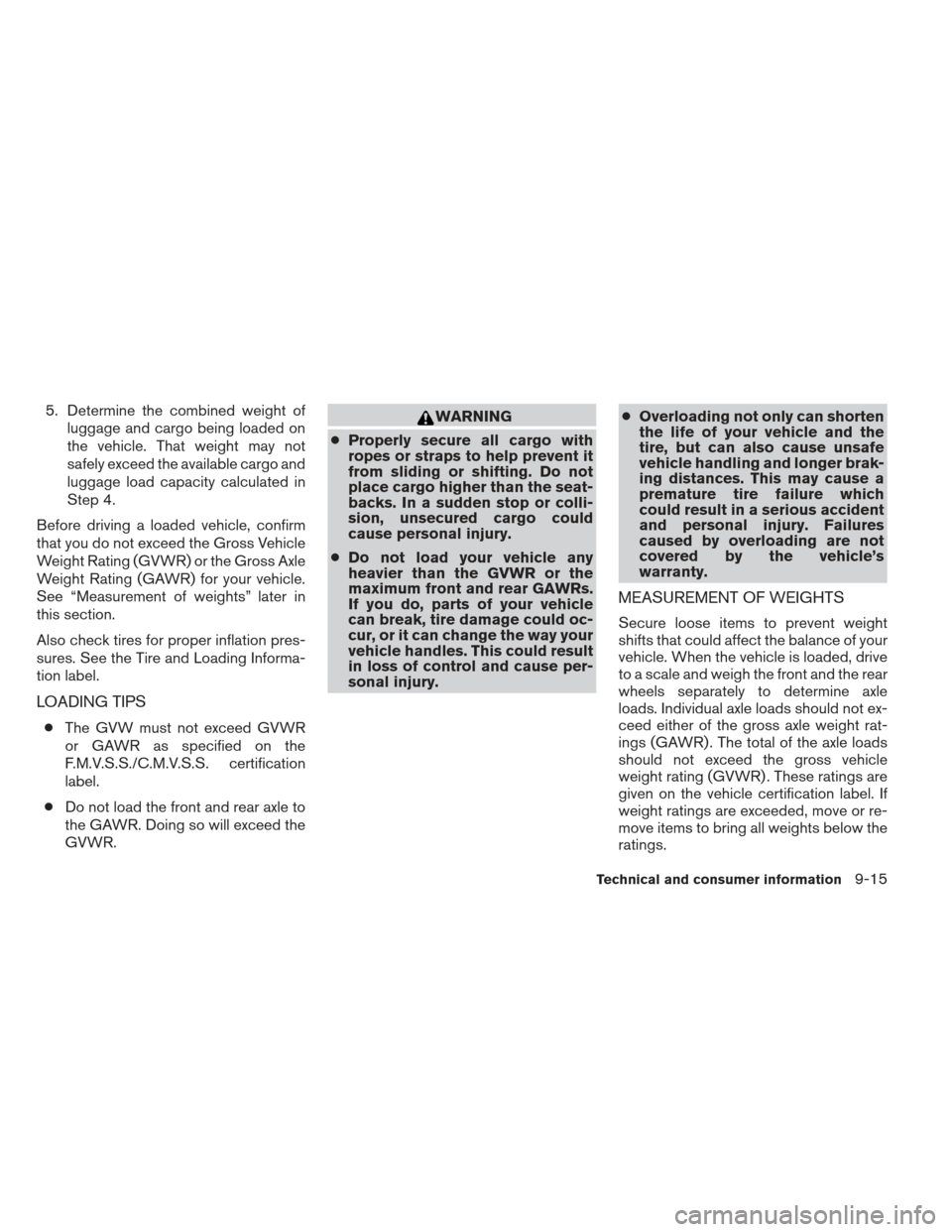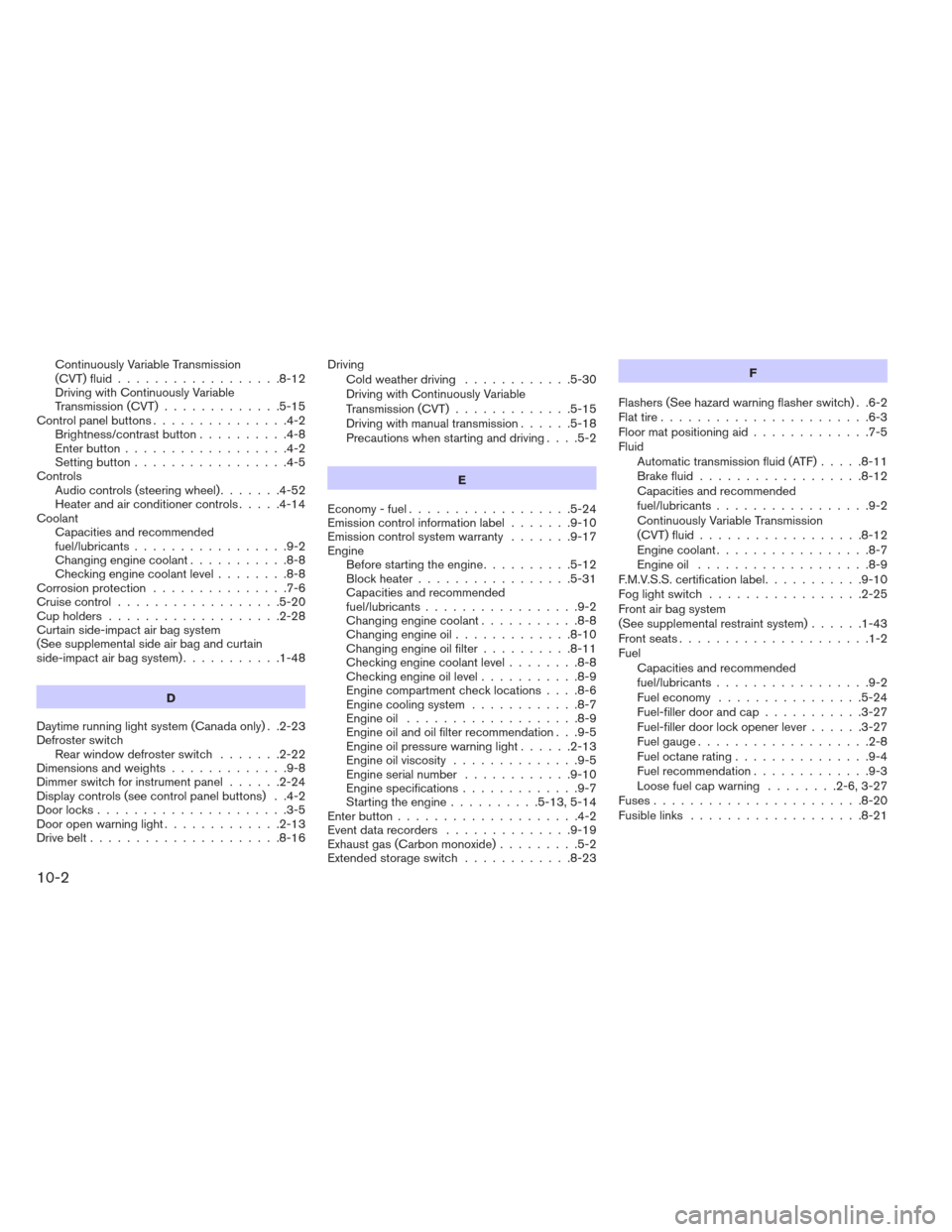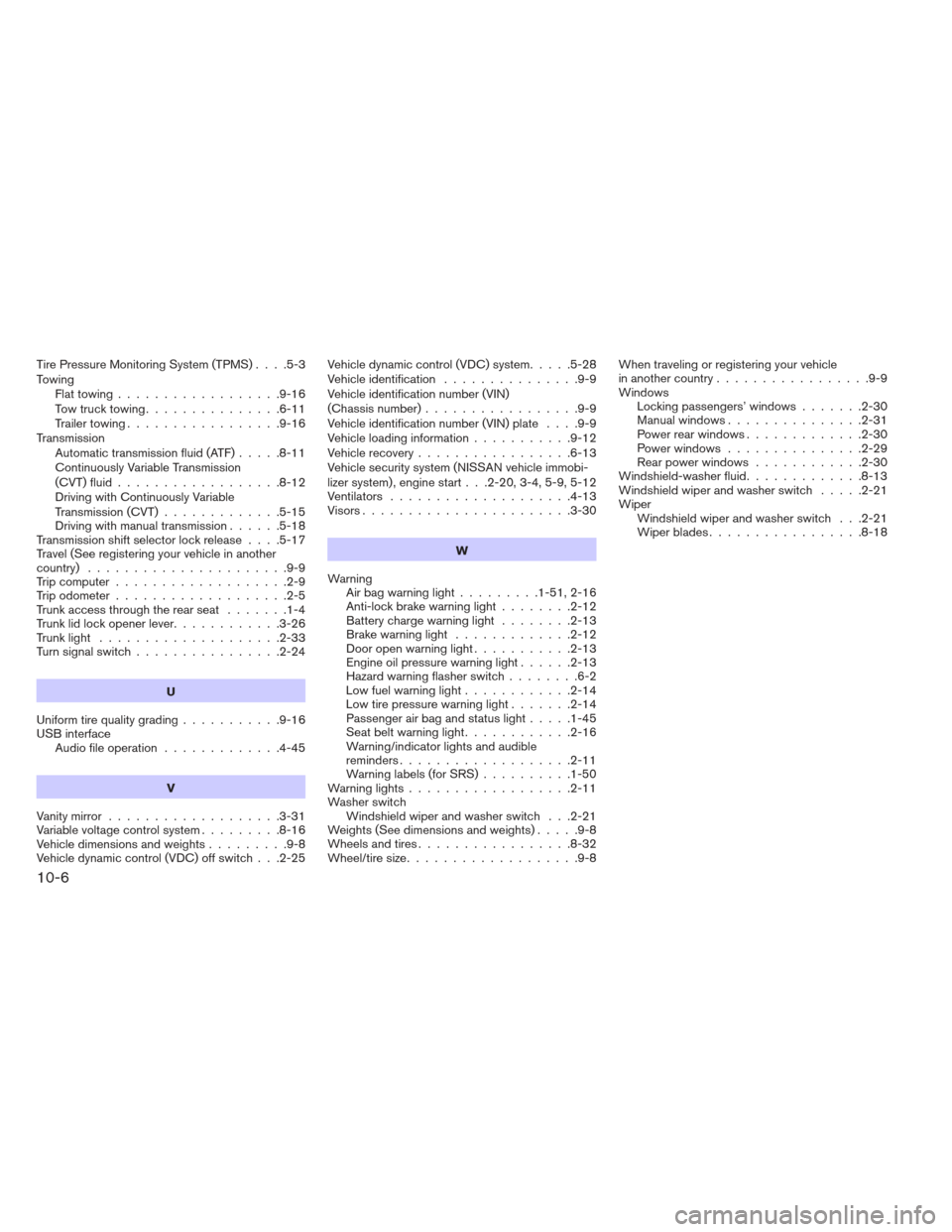2013 NISSAN VERSA SEDAN weight
[x] Cancel search: weightPage 317 of 331

Steps for determining correct load
limit
1. Locate the statement “The combinedweight of occupants and cargo
should never exceed XXX kg or XXX
lbs” on your vehicle’s placard.
2. Determine the combined weight of the driver and passengers that will be
riding in your vehicle.
3. Subtract the combined weight of the driver and passengers from XXX kg
or XXX lbs.
4. The resulting figure equals the avail- able amount of cargo and luggage
load capacity. For example, if the
XXX amount equals 1,400 lbs. and
there will be five 150 lb. passengers
in your vehicle, the amount of avail-
able cargo and luggage load capac-
ity is 650 lbs. (1,400-750 (5 X 150)
= 650 lbs) or (640-340 (5 X 70) =
300 kg.)
Example
WTI0169
9-14Technical and consumer information
Page 318 of 331

5. Determine the combined weight ofluggage and cargo being loaded on
the vehicle. That weight may not
safely exceed the available cargo and
luggage load capacity calculated in
Step 4.
Before driving a loaded vehicle, confirm
that you do not exceed the Gross Vehicle
Weight Rating (GVWR) or the Gross Axle
Weight Rating (GAWR) for your vehicle.
See “Measurement of weights” later in
this section.
Also check tires for proper inflation pres-
sures. See the Tire and Loading Informa-
tion label.
LOADING TIPS
● The GVW must not exceed GVWR
or GAWR as specified on the
F.M.V.S.S./C.M.V.S.S. certification
label.
● Do not load the front and rear axle to
the GAWR. Doing so will exceed the
GVWR.
WARNING
● Properly secure all cargo with
ropes or straps to help prevent it
from sliding or shifting. Do not
place cargo higher than the seat-
backs. In a sudden stop or colli-
sion, unsecured cargo could
cause personal injury.
● Do not load your vehicle any
heavier than the GVWR or the
maximum front and rear GAWRs.
If you do, parts of your vehicle
can break, tire damage could oc-
cur, or it can change the way your
vehicle handles. This could result
in loss of control and cause per-
sonal injury. ●
Overloading not only can shorten
the life of your vehicle and the
tire, but can also cause unsafe
vehicle handling and longer brak-
ing distances. This may cause a
premature tire failure which
could result in a serious accident
and personal injury. Failures
caused by overloading are not
covered by the vehicle’s
warranty.
MEASUREMENT OF WEIGHTS
Secure loose items to prevent weight
shifts that could affect the balance of your
vehicle. When the vehicle is loaded, drive
to a scale and weigh the front and the rear
wheels separately to determine axle
loads. Individual axle loads should not ex-
ceed either of the gross axle weight rat-
ings (GAWR) . The total of the axle loads
should not exceed the gross vehicle
weight rating (GVWR) . These ratings are
given on the vehicle certification label. If
weight ratings are exceeded, move or re-
move items to bring all weights below the
ratings.
Technical and consumer information9-15
Page 325 of 331

Continuously Variable Transmission
(CVT) fluid..................8-12
Driving with Continuously Variable
Transmission (CVT) .............5-15
Controlpanelbuttons...............4-2 Brightness/contrast button ..........4-8
Enterbutton..................4-2
Setting button .................4-5
Controls Audiocontrols(steeringwheel).......4-52
Heater and air conditioner controls .....4-14
Coolant Capacities and recommended
fuel/lubricants .................9-2
Changing engine coolant ...........8-8
Checking engine coolant level ........8-8
Corrosionprotection ...............7-6
Cruise control ..................5-20
Cupholders...................2-28
Curtain side-impact air bag system
(See supplemental side air bag and curtain
side-impact air bag system) ...........1-48
D
Daytime running light system (Canada only) . .2-23
Defroster switch Rear window defroster switch .......2-22
Dimensionsandweights.............9-8
Dimmer switch for instrument panel ......2-24
Display controls (see control panel buttons) . .4-2
Door locks .....................3-5
Door open warning light .............2-13
Drive belt .....................8-16 Driving
Cold weather driving ............5-30
Driving with Continuously Variable
Transmission (CVT) .............5-15
Driving with manual transmission ......5-18
Precautions when starting and driving ....5-2
E
Economy - fuel ..................5-24
Emission control information label .......9-10
Emission control system warranty .......9-17
Engine Before starting the engine ..........5-12
Block heater .................5-31
Capacities and recommended
fuel/lubricants .................9-2
Changing engine coolant ...........8-8
Changing engine oil .............8-10
Changing engine oil filter ..........8-11
Checking engine coolant level ........8-8
Checking engine oil level ...........8-9
Engine compartment check locations ....8-6
Engine cooling system ............8-7
Engineoil ...................8-9
Engine oil and oil filter recommendation . . .9-5
Engine oil pressure warning light ......2-13
Engine oil viscosity ..............9-5
Engine serial number ............9-10
Engine specifications .............9-7
Starting the engine ..........5-13,5-14
Enterbutton....................4-2
Eventdatarecorders ..............9-19
Exhaust gas (Carbon monoxide) .........5-2
Extended storage switch ............8-23 F
Flashers (See hazard warning flasher switch) . .6-2
Flat tire .......................6-3
Floor mat positioning aid .............7-5
Fluid Automatic transmission fluid (ATF) .....8-11
Brake fluid ..................8-12
Capacities and recommended
fuel/lubricants .................9-2
Continuously Variable Transmission
(
CVT)fluid..................8-12
Engine coolant .................8-7
Engine oil ...................8-9
F.M.V.S.S. certification label ...........9-10
Foglightswitch .................2-25
Front air bag system
(See supplemental restraint system) ......1-43
Front seats .....................1-2
Fuel Capacities and recommended
fuel/lubricants .................9-2
Fuel economy ................5-24
Fuel-filler door and cap ...........3-27
Fuel-filler door lock opener lever ......3-27
Fuelgauge...................2-8
Fuel octane rating ...............9-4
Fuel recommendation .............9-3
Loose fuel cap warning ........2-6,3-27
Fuses.......................8-20
Fusiblelinks ...................8-21
10-2
Page 329 of 331

Tire Pressure Monitoring System (TPMS)....5-3
Towing Flattowing..................9-16
Towtrucktowing...............6-11
Trailertowing.................9-16
Transmission Automatic transmission fluid (ATF) .....8-11
Continuously Variable Transmission
(CVT) fluid ..................8-12
Driving with Continuously Variable
Transmission (CVT) .............5-15
Driving with manual transmission ......5-18
Transmission shift selector lock release ....5-17
Travel (See registering your vehicle in another
country) ......................9-9
Trip computer ...................2-9
Trip odometer ...................2-5
Trunk access through the rear seat .......1-4
Trunk lid lock opener lever ............3-26
Trunklight ....................2-33
Turnsignalswitch................2-24
U
Uniform tire quality grading ...........9-16
USB interface Audio file operation .............4-45
V
Vanity mirror ...................3-31
Variable voltage control system .........8-16
Vehicle dimensions and weights .........9-8
Vehicle dynamic control (VDC) off switch . . .2-25 Vehicle dynamic control (VDC) system
.....5-28
Vehicle identification ...............9-9
Vehicle identification number (VIN)
(Chassis number) .................9-9
Vehicle identification number (VIN) plate ....9-9
Vehicle loading information ...........9-12
Vehicle recovery .................6-13
Vehicle security system (NISSAN vehicle immobi-
lizer system) , engine start . . .2-20, 3-4, 5-9, 5-12
Ventilators ....................4-13
Visors.......................3-30
W
Warning Air bag warning light .........1-51,2-16
Anti-lock brake warning light ........2-12
Battery charge warning light ........2-13
Brake warning light .............2-12
Door open warning light ...........2-13
Engine oil pressure warning light ......2-13
Hazard warning flasher switch ........6-2
Low fuel warning light ............2-14
Low tire pressure warning light .......2-14
Passenger air bag and status light .....1-45
Seatbeltwarninglight............2-16
Warning/indicator lights and audible
reminders ...................2-11
Warning labels (for SRS) ..........1-50
Warning lights ..................2-11
Washer switch Windshield wiper and washer switch . . .2-21
Weights (See dimensions and weights) .....9-8
Wheels and tires .................8-32
Wheel/tire size ...................9-8 When traveling or registering your vehicle
in another country
.................9-9
Windows Locking passengers’ windows .......2-30
Manual windows ...............2-31
Power rear windows .............2-30
P
ower windows ...............2-29
Rear power windows ............2-30
Windshield-washer fluid .............8-13
Windshield wiper and washer switch .....2-21
Wiper Windshield wiper and washer switch . . .2-21
Wiperblades.................8-18
10-6